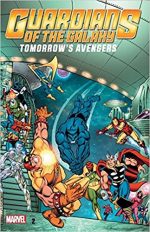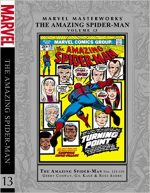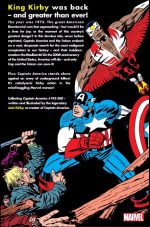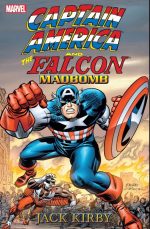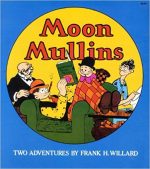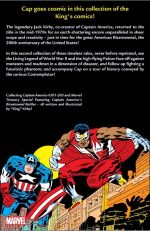
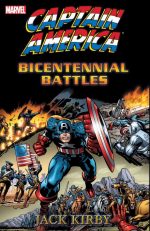
By Jack Kirby with Herb Trimpe, Barry Windsor-Smith, John Romita Sr., Bob Smith, Frank Giacoia, John Verpoorten & various (Marvel)
ISBN: 978-0-7851-1726-1)
These days Captain America is as much a global symbol of the Land of the Free and the Home of the Brave as Uncle Sam or Apple Pie ever were so I’m enjoying a lazy and rather obvious way to celebrate Independence Day by recommending this bombastic blockbuster featuring material first seen in 1976 as the nation commemorated its first 200 years.
The immortal Sentinel of Liberty was dreamed up by Joe Simon & Jack Kirby at a time of increasing national tension in an era of fervent patriotic fervour: Captain America was a dynamic and highly visible response to the horrors of Nazism and the threat of Liberty’s loss.
He quickly lost focus and popularity after hostilities ceased: fading during post-war reconstruction to briefly reappear after the Korean War: a harder, darker sentinel ferreting out monsters, subversives and the “commies†who lurked under every American bed. Then he vanished once more until the burgeoning Marvel Age resurrected him just in time to experience the Republic’s most turbulent and culturally divisive era.
He quickly became a mainstay of the Marvel Revolution during the Swinging Sixties but lost his way somewhat after that, except for a glittering period under scripter Steve Englehart. Eventually however he too moved on and out in the middle of the 1970s.
After nearly a decade drafting almost all of Marvel’s successes, Jack Kirby had become increasingly burdened by Marvel’s growing success and unwillingness to let him experiment, so he had jumped ship to arch-rival DC in 1971, creating a whole new mythology and dynamically inspiring pantheon.
Eventually he accepted that editors made the same promises everywhere, and that even he could never win against any short-sighted publishing company’s excessive pressure to produce and constant interfering g micro-managing.
Kirby exploded back into the Marvel Universe in 1976 with a promise of free rein, concocting a stunning wave of iconic creations (2001: A Space Odyssey, Machine Man, The Eternals, Devil Dinosaur). Simultaneously he was handed control of two of his previous co-creations – firmly established superhero characters Black Panther and Captain America – to do with as he wished…
His return was much hyped at the time but swiftly became controversial as his intensely personal visions paid little lip service to company continuity as Jack went explosively his own way.
Whilst his new works quickly found many friends, his tenure on those earlier inventions drastically divided the fan base. Kirby was never slavishly wedded to tight continuity and preferred, in many ways, to treat his stints on any strip as creative “Day Onesâ€. This was never more apparent than in the pages of the Star-Spangled Sentinel of Liberty…
This titanic trade paperback/eBook collection reprints Captain America’s Bicentennial Battles and Captain America #201-205 (September 1976 – January1977) with Kirby as writer, artist and editor, exploring his own notions of the American Dream as seen through the lens of the nation’s premiere comicbook patriotic symbol in the year of the nation’s 200th anniversary…
Captain America’s Bicentennial Battles was originally released as part of the nationwide celebration of the USA’s two hundredth year in Marvel’s tabloid-sized Treasury Format (80+ pages of 338 x 258mm dimensions) and took the Star-Spangled Avenger on an incredible excursion through the key eras and areas of American history.
A vast, expansive, panoramic and iconic celebration of the memory and the myth of the nation, this almost abstracted and heavily symbolic 84-page extravaganza perfectly survives the surrender of colour and reduction to standard comic dimensions, following Captain America when cosmic savant (and retrofitted Elder of the Universe The Contemplator) Mister Buda propelled the querulous hero into successively significant segments of history.
Enduring a blistering pace of constant change, Captain America encounters lost partner Bucky during WWII, meets Benjamin Franklin in Revolutionary Philadelphia and revisits the mobster-ridden depression era of Steve Roger‘s childhood as ‘The Lost Super-Hero!’.
In ‘My Fellow Americans’ Cap confronts Geronimo during the Indian Wars and suffers the horrors of a mine cave-in, before ‘Stop Here for Glory!’ finds him surviving a dogfight with a German WWI fighter ace, battling bare-knuckle boxer John L. Sullivan, resisting slavers with abolitionist John Brown, and observing both the detonation of the first Atom Bomb and the Great Chicago Fire…
‘The Face of the Future!’ even sees him slipping into the space colonies of America’s inevitable tomorrows before segueing into pure emotional fantasy by experiencing the glory days of Hollywood, the simple joys of rural homesteading and the harshest modern ghetto, before drawing strength from the nation’s hopeful children…
Inked by such luminaries as Barry Windsor-Smith, John Romita Sr. and Herb Trimpe, the book-length bonanza is peppered with a glorious selection of pulsating pin-ups.
After thus exotically absorbing the worth of a nation, the Star-Spangled Avenger reunites with his partner for Captain America and the Falcon #201, set in the aftermath of their struggle to stop a deranged aristocrat rolling back the American Revolution…
The pace then shifts to malevolent moodiness and uncanny mystery with the introduction of ‘The Night People!’: a street-full of mutants and maniacs who periodically phase into and out of New York City, creating terror and chaos with every sunset. When Falcon Sam Wilson and girlfriend Leila are abducted by the eerie encroachers, they are quickly converted to their crazed cause by exposure to the ‘Mad, Mad Dimension!’ the vile visitors inhabit during daylight hours. This leaves Captain America and folksy new colleague Texas Jack Muldoon hopelessly outgunned when their last-ditch rescue attempt results in them all battling an invasion of brutally berserk beasts in ‘Alamo II!’
On bludgeoning, bombastic top-form, the Star-Spangled Avenger saves the day once more, but no sooner are the erstwhile inhabitants of Zero Street safely ensconced on Earth than ‘The Unburied One!’ has the indefatigable champions battling against a corpse who won’t play dead. The concluding chapter and last tale in this thrilling tome reveal the cadaver has become home to an energy-being from the far future as ‘Agron Walks the Earth!’ Thankfully, not even its pulsating power and rage can long baulk the indomitable spirit and ability of America’s Ultimate Fighting Man…
The King’s commitment to wholesome adventure, breakneck action and breathless wonderment, combined with his absolute mastery of the comic page and unceasing quest for the Next Big Thrill, always make for a captivating read and this stuff is as good as anything Jack crafted over his decades of creative brilliance.
Fast-paced, action-packed, totally engrossing Fights ‘n’ Tights masterpieces no fan should ignore and, above all else, fabulously fun tales of a true American Dream…
© 1976, 1977, 2005, 2016 Marvel Characters, Inc. All rights reserved.





